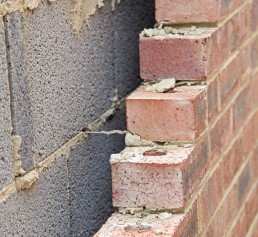Why Double Brick
Double Brick is the most common method of construction in WA.

Construction consists of two panels (sometimes called leaves) of masonry with a cavity between them. The panels are connected by steel ties at regular intervals.
A better description would be Structural Masonry, Cavity Construction. which also includes using limestone, rendered brick and concrete block for the external face, and brick or concrete block for the internal leaf. (The photo shows a brick external leaf connected to a concrete block inner leaf by a wire tie)
The purpose of the cavity between the outside leaf of brick and the inside leaf is so that moisture doesn’t penetrate into the home. In more sustainable homes this cavity is partially or fully filled with insulation.
Internal walls are usually a single brick thickness and generally use a 2nds brick or concrete block that is plastered or lined using a lining board.
Advantages
- It is extremely durable requiring very little maintenance.
- The mass of the brickwork can help moderate the internal temperature of the dwelling
- You can place a heavy fixing anywhere on the walls.
Disadvantages
- More expensive than Brick Veneer.
- Not as well insulated.
- The house will take a long time to warm up in winter or cool down once it does get hot.
- Likely to crack if subjected to ground movement.
Also see: Brick Veneer.
See this link for more posts: Bricks
Masonry is generally a highly durable form of construction. However, the materials used, the quality of the mortar and workmanship, and the pattern in which the units are assembled can significantly affect the durability of the overall masonry construction.
And probably the most important of all the quality of the foundations. See Brick Fences for wall foundations.
Brian
Note: Never fill the cavity behind the brick veneer with an insulation product as this will seriously alter the weatherproofing performance of the cladding.
I would agree that its not the best idea to “fill” the cavity, but its quite acceptable to have some insulation in the cavity.
Brian